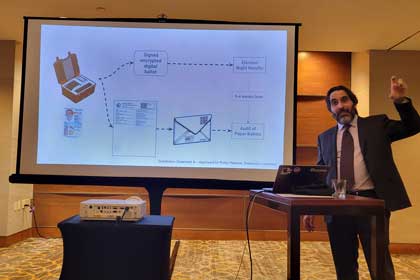
Ben Adida, executive director of nonprofit voting technology company VotingWorks, provides a presentation on an early-stage prototype of voting technology aimed at improving the experience of military absentee voters at the National Association of State Election Directors Conference in Washington, D.C., Feb. 7, 2024. Researchers from the Defense Advanced Research Agency and Voting Works unveiled the prototype as part of a two-year, joint research project to explore voting solutions for service members stationed away from their home voting districts.
Researchers set out to tackle voting challenges of military members
by Joseph Clark , DOD News
Researchers from nonprofit election technology company VotingWorks showcased an early-stage prototype of technology aimed at improving the experience of military absentee voters, Feb. 7.
The prototype was presented during the National Association of Secretaries of State and the National Association of State Election Directors conferences in Washington, D.C., last week. It was unveiled midway into a two-year, research project funded by the Defense Advanced Research Projects Agency to explore methods to ease burdens for service members stationed away from their home voting districts.
"We want military voters to be first-class voters and have the same abilities as other voters," said Ben Adida, the executive director of VotingWorks and the technical lead on the project.
In describing their specific goals for the project, the research team said military voters should have the ability to cast a privacy-protected ballot through election day, receive a paper ballot for verifiability, and confirm that their vote was counted.
The research team also wants those ballots to be counted as part of election night results, or soon thereafter, similar to the in-person ballots cast at a service member's regular polling center.
"We want them to be a part of that because that's an important part of being and feeling enfranchised during the voting process," Adida said.
While the majority of service members, 75%, are eligible to vote absentee because they are stationed away from their home voting precincts, doing so is often more complicated according to analysis conducted by the Federal Voting Assistance Program.
Service members must explicitly request absentee ballots and follow their state's specific rules about how their ballot can be sent and received. Military absentee voters often send their ballots to be counted via an ad hoc mix of fax, email and mail that could potentially compromise the security of their ballots.
In some cases, state absentee voting measures require access to technology not readily available while deployed, and often require military voters to vote earlier than their civilian counterparts due to long mailing timelines.
Those challenges, in part, translate to lower turnout by military members when compared with civilian voters, according to FVAP figures.
The FVAP found that, in 2020 military voter turnout was 27 percentage points lower than civilian voters with similar characteristics.
That year, turnout among civilian voters with similar demographics to military voters was 74%, the highest since 1900. Military turnout in 2020 was 47%, comparable to 46% in 2016, the FVAP found.
The early-stage solution presented by the research team this week is a deployable terminal that would allow military voters to transmit a signed, encrypted digital ballot to their home precinct on election day using their common access card.
Common access cards, which are issued to every member of the military, include strong authentication capabilities and digital signatures key to ensuring the authenticity of the digitally transmitted ballots.
The terminal would also print paper ballot along with a mailing label to be sent to the service member's home state for audits – which usually occur up to four weeks after Election Day.
Adida said that separation between when the digital vote is counted and when the audit of paper ballots is performed is the key observation underlying the solution.
"Our work is about figuring out what we can do with that extra time," he said. "Because the audit that requires a paper ballot, doesn't need to happen for a bunch of days after the election results."
Essentially, by capitalizing on the extra time, service members would no longer have to mail in a paper ballot – used for both the initial vote count and in the audit – in advance.
Adida said that the prototype reflects the critical importance to producing that paper ballot that can be verified by the voter and subsequently audited by election officials.
He emphasized that the scope of the project is to produce a solution specifically for military absentee voters that meets the same standards required by civilian voters.
"We are well aware that whenever you tackle military voting, the first thing that comes to mind is internet voting," Adida said. "We are holding a hard line that voters should have a voter-verified paper ballot that's part of an audit when all is said and done."
The research team emphasized that they are still in the early stages of prototype development, but say they are hoping to pilot a prototype in 2025.
"We recognize we're not going to solve this problem overnight," said Steve Trout, VotingWork's head of government partnerships.
"We're still not going to solve this problem for every military voter with this first version, and I've just accepted that at least for now, we're not going to get ballots transmitted from submarines," he said.
But he said the project will still be a success if the team is able to provide a solution that eases the voting process for most military voters.
"Logistically some things are just going to be impossible to do," Trout said. "But we don't want that to discourage us if we can help increase voter turnout by 20%. That's a huge win."
Military News | Navy News | Tackling military voting challenges


